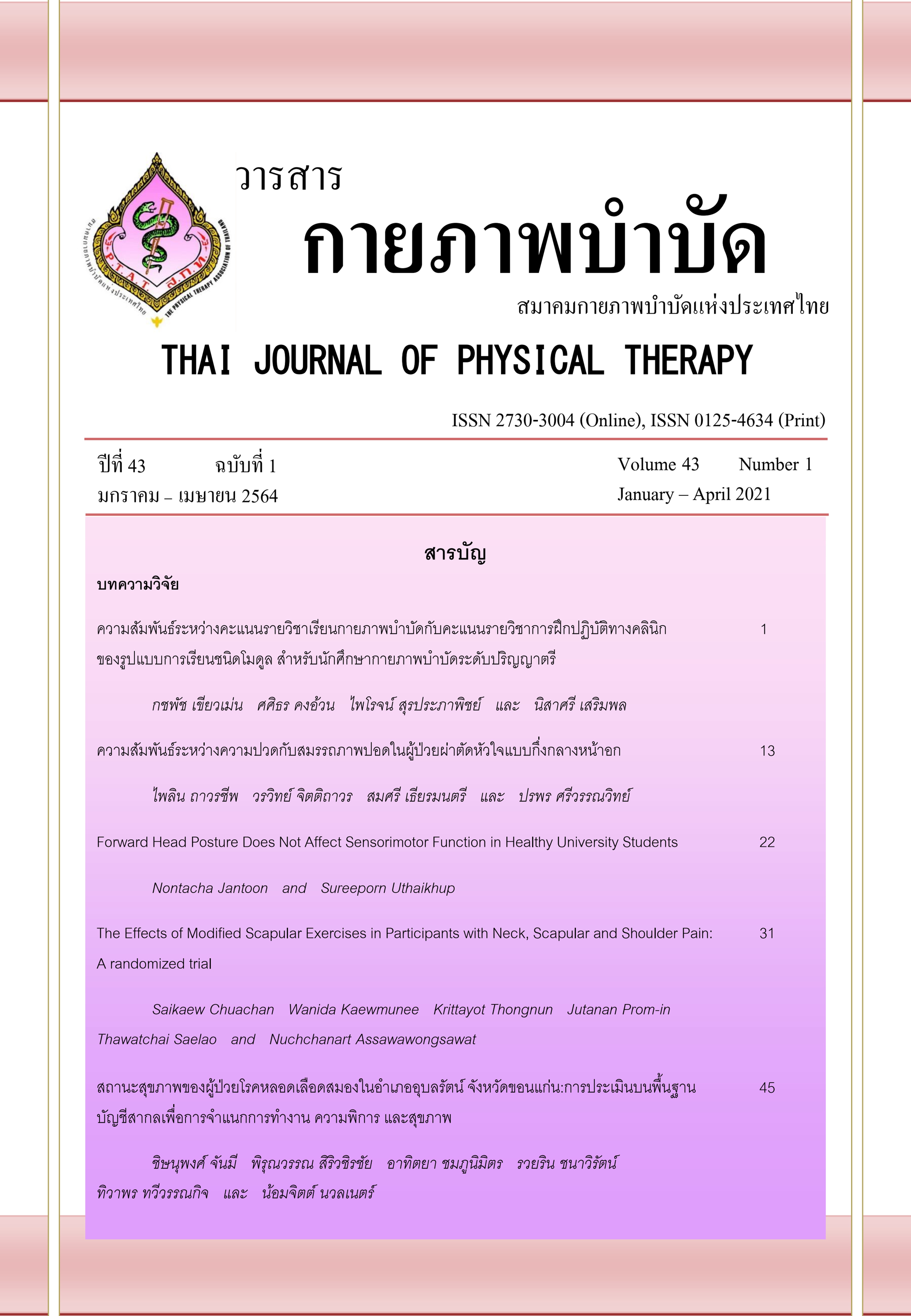สถานะสุขภาพของผู้ป่วยโรคหลอดเลือดสมองในอำเภออุบลรัตน์ จังหวัดขอนแก่น: การประเมินบนพื้นฐานบัญชีสากลเพื่อการจำแนกการทำงาน ความพิการ และสุขภาพ
Main Article Content
บทคัดย่อ
ที่มาและความสำคัญ: International Classification of Functioning, Disability and Health (ICF) เป็นกรอบความคิดที่ใช้ในการอธิบายสุขภาพและปฏิสัมพันธ์อย่างเป็นองค์รวมระหว่างสุขภาพกับองค์ประกอบที่เกี่ยวข้องกับสุขภาพ โรงพยาบาลอุบลรัตน์ จังหวัดขอนแก่น ต้องการรวบรวมข้อมูลสถานะสุขภาพปัจจุบันของผู้ป่วยโรคหลอดเลือดสมองในอำเภออุบลรัตน์ โดยใช้การตรวจประเมินบนพื้นฐาน ICF
วัตถุประสงค์: เพื่อประเมินสถานะสุขภาพด้านการทำงานและโครงสร้างของร่างกาย การทำกิจกรรม และการมีส่วนร่วมในกิจกรรมทางสังคมของผู้ป่วยโรคหลอดเลือดสมองในอำเภออุบลรัตน์ จังหวัดขอนแก่น
วิธีการวิจัย: ผู้ป่วยโรคหลอดเลือดสมองจำนวน 46 ราย (อายุเฉลี่ย 71.9±9.2 ปี ระยะเวลาการเป็นโรคเฉลี่ย 57.9±54.1 เดือน) ได้รับการประเมินสถานะสุขภาพบนพื้นฐานบัญชีสากลเพื่อการจำแนกการทำงาน ความพิการ และสุขภาพ โดยประเมินการทำงานและโครงสร้างของร่างกายด้วยการสัมภาษณ์ การสังเกต การคลำ และการเคลื่อนไหวผู้ป่วย ประเมินการทำกิจกรรมด้วยแบบประเมิน Stroke Rehabilitation Assessment of Movement ร่วมกับแบบประเมิน Barthel Index และประเมินการมีส่วนร่วมในกิจกรรมทางสังคมด้วยแบบประเมิน Stroke Impact Scale หมวดการสื่อสารและหมวดการมีส่วนร่วมในกิจกรรมทางสังคม
ผลการวิจัย: สถานะสุขภาพด้านการทำงานและโครงสร้างของร่างกายที่เป็นปัญหาของผู้ป่วยอย่างเด่นชัด ได้แก่ ความตึงตัวของกล้ามเนื้อรยางค์บนและล่างสูงกว่าปกติ ความผิดปกติของข้อไหล่ และความผิดปกติของความยาวของกล้ามเนื้อรยางค์ล่าง สถานะสุขภาพด้านการทำกิจกรรมมีปัญหาทั้งด้านการเคลื่อนไหวของรยางค์และการเคลื่อนไหวพื้นฐานในชีวิตประจำวัน นอกจากนี้ ผู้ป่วยยังมีความสามารถในการมีส่วนร่วมในกิจกรรมทางสังคมค่อนข้างน้อยอีกด้วย
สรุปผล: ผู้ป่วยโรคหลอดเลือดสมองในอำเภออุบลรัตน์มีปัญหาสถานะสุขภาพทั้งด้านการทำงานและโครงสร้างของร่างกาย การทำกิจกรรม และการมีส่วนร่วมในกิจกรรมทางสังคม ข้อมูลทั้งหมดนี้น่าจะเป็นประโยชน์ต่อโรงพยาบาลอุบลรัตน์สำหรับการพัฒนาคุณภาพการบริการเพื่อสร้างเสริมคุณภาพชีวิตของผู้ป่วยโรคหลอดเลือดสมองต่อไป
Article Details
เอกสารอ้างอิง
World Health Organization. International Classification of Functioning, Disability and Health: ICF. Geneva: WHO; 2001.
Jette AM. Toward a common language for function, disability, and health. Phys Ther. 2006; 86(5): 726-34.
Tongsiri S. Use of the International Classification of Functioning, Disability and Health (ICF) to develop database of persons with disabilities (PWDs). Srinagarind Med J. 2013; 28(1): 131-42.
Tiamkao S, Singhpoo K, Kongbunkiat K, Auantri P. eds. A manual of entire stroke service system management. Khon Kaen: Klang Na Na Vithaya, 2012.
Adamson J, Beswick A, Ebrahim S. Is stroke the most common cause of disability? J Stroke Cerebrovasc Dis. 2004; 13(4): 171-7.
Patel MD, Tilling K, Lawrence E, Rudd AG, Wolfe CD, McKevitt C. Relationships between long-term stroke disability, handicap and health-related quality of life. Age Ageing. 2006; 35(3): 273-9.
Nualnetr N, Srisoparb W, Eungpinichpong W.The application of community neurorehabilitation using a family-centred approach to persons with disability: a case study in stroke survivors. Asia Pacific Disabil Rehabil J. 2010; 21(1): 71-9.
Thai Stroke Society. Strategic health plan in Thai lifestyle 2011-2020. Bulletin of the Thai Stroke Society, 2010.
National Health Commission Office. National Health Act, B.E. 2550. Nonthaburi: National Health Commission Office, 2007.
Petchroung N, Priyatruk P, Thongkeang V. The study of continuing care for patients with cerebrovascular disease in primary care unit. J Royal Thai Army Nurses. 2013; 14(1): 25-34.
Prodbumrung J. Complications following hemiparesis in stroke patients. Buddhachinaraj Med J. 2014; 31(3): 376-84.
Phinyo P, Phinyo K, Limtragool P, Tiamkao S, Worawong C, Chuasuan W, et al. Care improvement for patients with stroke through community participation. Songklanagarind J Nurs. 2015; 35(2): 93-112.
Chuyingsakultip N, Chanchai A, Gadudom P, Kaewdang K. Quality of life of acute ischemic stroke patients in the Stroke Unit, Rayong Hospital. J Phrapokklao Nurs Coll. 2016; 27(2): 54-64.
Tepsimanon N, Weerapal S, Sritrairut A. The relationships between balance and activities of daily living performance of stroke patients in Muang District, Surat Thani Province. J Prevent Med Assoc Thai. 2018; 8(2): 237-46.
Srisoparb W, Nualnetr N, Sommanochai K, Karinta N, Charungthanakij P. Upper limb functional ability of Individuals with chronic stroke in communities of Naresuan University Hospital. Thai J Phys Ther. 2019; 41(2): 60-74.
Seephim B, Srisoparb W, Nualnetr N. Upper limb functions and complications of hemiplegic side in patients with chronic stroke in the community. Srinagarind Med J. 2020; 35(1): 51-8.
Daley K, Mayo N, Wood-Dauphinee S. Reliability of scores on the Stroke Rehabilitation Assessment of Movement (STREAM) measure. Phys Ther. 1999; 79(1): 8-23.
Granger CV, Dewis LS, Peters NC, Sherwood CC, Barrett JE. Stroke rehabilitation: analysis of repeated Barthel index measures. Arch Phys Med Rehabil. 1979; 60(1): 14-7.
Piriyaprasarth P. Stroke assessment tools. Thai J Phys Ther. 2016; 38(3): 128-39.
Garnjanagoonchorn A, Dajpratham P. Reliability and validity of the Thai version of the Stroke Impact Scale (SIS) 3.0. J Thai Rehabil Med. 2015; 25(2): 45-52.
Sriprachya-anunt S. Medical rehabilitation manual for physician about the prevention and rehabilitation services for persons with disability. Bangkok: War Veterans Organization of Thailand Printing; 1995.
Hollis M. Passive movements. In: Hollis M, Fletcher-Cook P. eds. Practical exercise therapy. 4th ed. London: Blackwell Science 1999: 62-75.
Kisner C, Colby LA. Therapeutic exercise: foundations and techniques. 3rd ed. Philadelphia: FA Davis 1996: 24-42.
Sungkarat S, Uthaikhup S, Keawsutthi M, Charoenlimprasert J, Kaewsanmuang S. Intra- and inter-rater reliability of the Stroke Rehabilitation Assessment of Movement (STREAM). J Assoc Med Sci. 2017; 50(1): 71-86.
Chaikeeree N, Wannapakhe J, Boonsinsukh R, Tantiwong K, Phetchatchan N, Wongkom T, et al. Stroke Rehabilitation Assessment of Movement Thai version (STREAM-TH): translation with reliability and concurrent validity study. Thai J Phys Ther. 2018; 40(1): 16-24.
Dajpratham P, Meenaphant R, Junthon P, Pianmanakij S, Jantharakasamjit S, Yuwan A. The inter-rater reliability of Barthel Index (Thai version) in stroke patients. J Thai Rehabil. 2006; 16(1): 1-9.
Duncan PW, Bode RK, Lai SM, Perera S. Rasch analysis of a new stroke-specific outcome scale: the Stroke Impact Scale. Arch Phys Med Rehabil. 2003; 84(7): 950-63.
Mulder M, Nijland R. Stroke Impact Scale. J Physiother. 2016; 62(2): 117.
Van Ouwenaller C, Laplace PM, Chantraine A. Painful shoulder in hemiplegia. Arch Phys Med Rehahil. 1986; 67(1): 23-36.
Nualnetr N. Principle in physical therapy for neurologic patients. Khon Kaen: Klang Na Na Vithaya, 2005.
Lang CE, Beebe JA. Relating movement control at 9 upper extremity segments to loss of hand function in people with chronic hemiparesis. Neurorehabil Neural Repair. 2007; 21(3): 279-91.
Johnstone M. Restoration of normal movement after stroke. London: Churchill Livingstone, 1995.
Doruk P. The impact of knee osteoarthritis on rehabilitation outcomes in hemiparetic stroke patients. J Back Musculoskelet Rehabil. 2013; 26(2): 207-11.
Peat G, McCarney R, Croft P. Knee pain and osteoarthritis in older adults: review of community burden and current use of primary care. Ann Rheum Dis. 2001; 60(2): 91-7.


